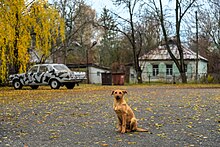Dogs in the Chernobyl exclusion zone

After the 1986 nuclear disaster in Chernobyl, the regional domestic dog population suffered from environmental pollution originating from the radiation. This disaster made the environment highly mutagenic, leading to various evolutionary processes including, but not limited to, bottlenecks, directional selection, and higher rates of mutation resulting in evolutionary trajectories that differ from unexposed animals.[1]
History
[edit]Origin of populations
[edit]
The exact origin of the populations of dogs living in the Chernobyl Nuclear Power Plant (CNPP) and the surrounding areas of the Chernobyl Exclusion Zone is unknown.[1] However, it is hypothesized that these animals are the descendants of pets left behind during the original evacuation of Pripyat. While many of these original pets population were killed by the Ukrainian Ministry of Internal Affairs to prevent the further spread of radiation,[2] the remainder survived to reproduce. There are currently two geographically and genetically distinct populations of dogs in the area, one in the CNPP and one in Chernobyl City.[1]
Population characteristics
[edit]At least 302 feral dogs live around the Chernobyl Exclusion Zone (CEZ). However, there are projections of up to a thousand individuals due to the present differences with the nearby populations (10 miles away).[1] They differentiate from populations only 16 km away. At least 15 families are living inside the area mostly related to shepherd breeds such as the German shepherds, characteristics shared by other feral dogs living in Eastern Europe.[3]
Evolutionary processes
[edit]Rapid evolution
[edit]The dogs suffer from radiation that may differentiate them genetically from the population of CEZ with their surroundings. Nevertheless, processes such as the high likelihood of inbreeding can lead to difficulties at the moment of analyzing their genome. In addition, the conditions of their habitat, human control in the access to the CEZ, may simulate an island habitat in terms of evolutionary processes such as isolation.[1]
Mutations
[edit]Despite the evidence of genetic differentiation mainly due to the radioactive environment, there is no support for pinpoint radiation as the primary driver of genetic differentiation; the evidence serves as insight for further research in these populations. Some regions of the genome indicate that they can be driven by directional selection. 391 outlier loci are influenced by directional selection, with at least 52 candidate genes[4]
Comparisons with unexposed populations
[edit]Genetic signatures of the Chernobyl dog populations have been compared to both pure-bred and free-breeding dog population genetic structures. The Chernobyl populations did not share increased similarity to pure-bred dogs, indicating that the populations of dogs of Chernobyl have not been inundated with individuals that are modern pets. Instead, this population is similar to free-breeding populations, indicating that the population has been established at least since the disaster in 1986. However, the Chernobyl dogs show enough differentiation from these populations that they can be used as a unique entity for further genomic study.[1]
Relief efforts
[edit]Since 2017, the Clean Futures Fund has implemented annual clinics in the Chernobyl exclusion zone to vaccinate, spay, and neuter the dogs of Chernobyl. This effort is made to reduce the risk of rabies passing to workers and tourists, to decrease the population size of the dogs, and to minimize the suffering that the dogs experience.[5] The dogs in the zone are able to recognize the uniforms of CFF personnel, and often avoid capture. For this reason, the CFF changes the color of their uniforms every year in order to vaccinate, spay, and neuter the dogs.[6]
References
[edit]- ^ a b c d e f Spatola, Gabriella J.; Buckley, Reuben M.; Dillon, Megan; Dutrow, Emily V.; Betz, Jennifer A.; Pilot, Małgorzata; Parker, Heidi G.; Bogdanowicz, Wiesław; Thomas, Rachel; Chyzhevskyi, Ihor; Milinevsky, Gennadi; Kleiman, Norman; Breen, Matthew; Ostrander, Elaine A.; Mousseau, Timothy A. (2023-03-03). "The dogs of Chernobyl: Demographic insights into populations inhabiting the nuclear exclusion zone". Science Advances. 9 (9): eade2537. Bibcode:2023SciA....9E2537S. doi:10.1126/sciadv.ade2537. ISSN 2375-2548. PMC 9984172. PMID 36867701.
- ^ Turnbull, Jonathon (December 2020). "Checkpoint dogs: Photovoicing canine companionship in the Chernobyl Exclusion Zone". Anthropology Today. 36 (6): 21–24. doi:10.1111/1467-8322.12620. ISSN 0268-540X.
- ^ "What the first look at the genetics of Chernobyl's dogs revealed". 2023-03-03. Retrieved 2024-05-07.
- ^ Dillon, Megan N.; Thomas, Rachael; Mousseau, Timothy A.; Betz, Jennifer A.; Kleiman, Norman J.; Reiskind, Martha O. Burford; Breen, Matthew (2023-03-08). "Population dynamics and genome-wide selection scan for dogs in Chernobyl". Canine Medicine and Genetics. 10 (1): 1. doi:10.1186/s40575-023-00124-1. ISSN 2662-9380. PMC 9993684. PMID 36890600.
- ^ "Dogs of Chernobyl". Clean Futures Fund. Retrieved 2024-05-07.
- ^ Hill, Kyle (2022-12-26). Chernobyl Created the World's Rarest Dogs. Event occurs at 6:59. Retrieved 2024-12-08 – via YouTube.
What the dogs have learned surviving in the zone all this time is actually one of the biggest problems for the Clean Futures Fund. Many dogs have memorized the uniforms of those trying to capture them for neutering and/or vaccination, and scatter at the sight of personnel. They are so good at memorizing humans, in fact, that every year the CFF has to change the colors of all of their uniforms.
